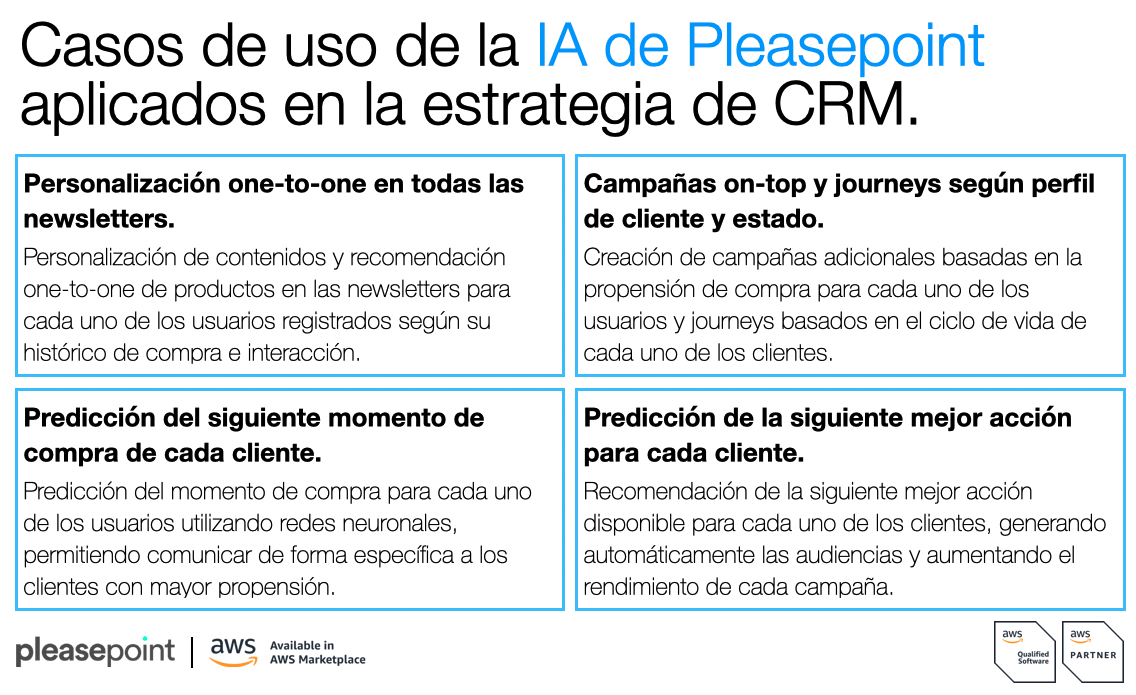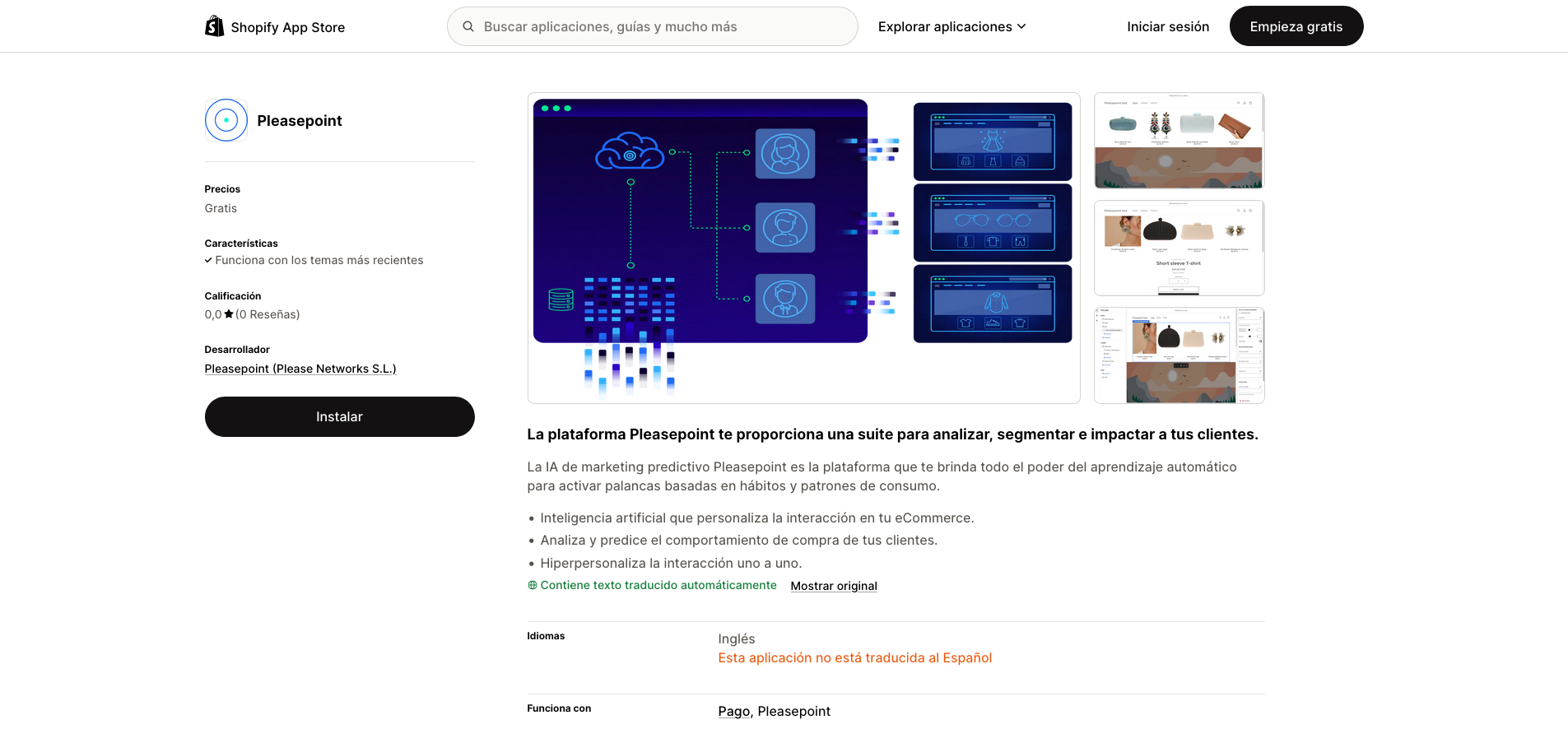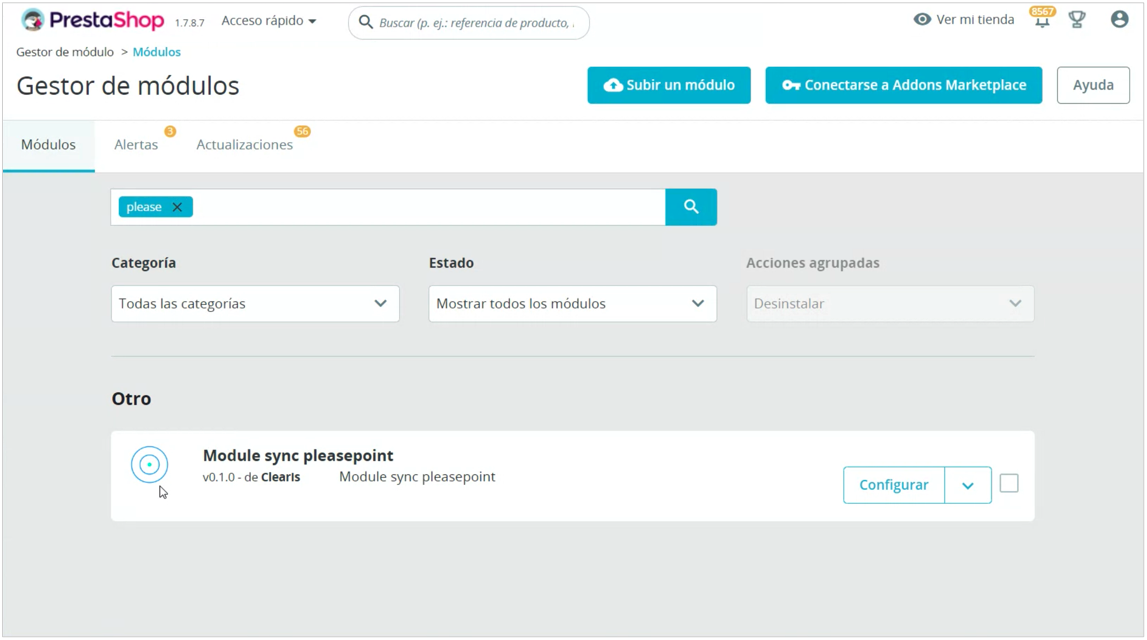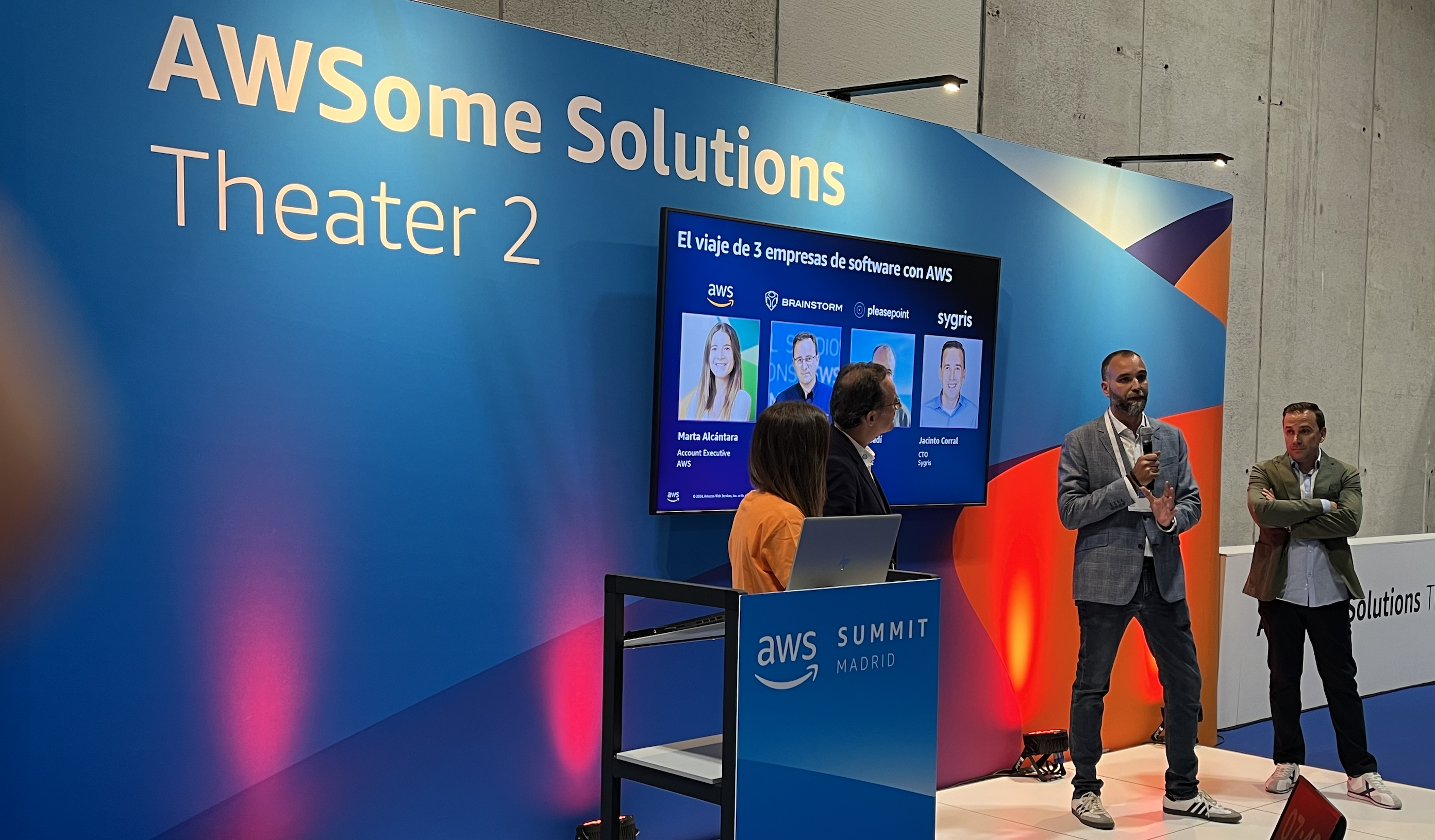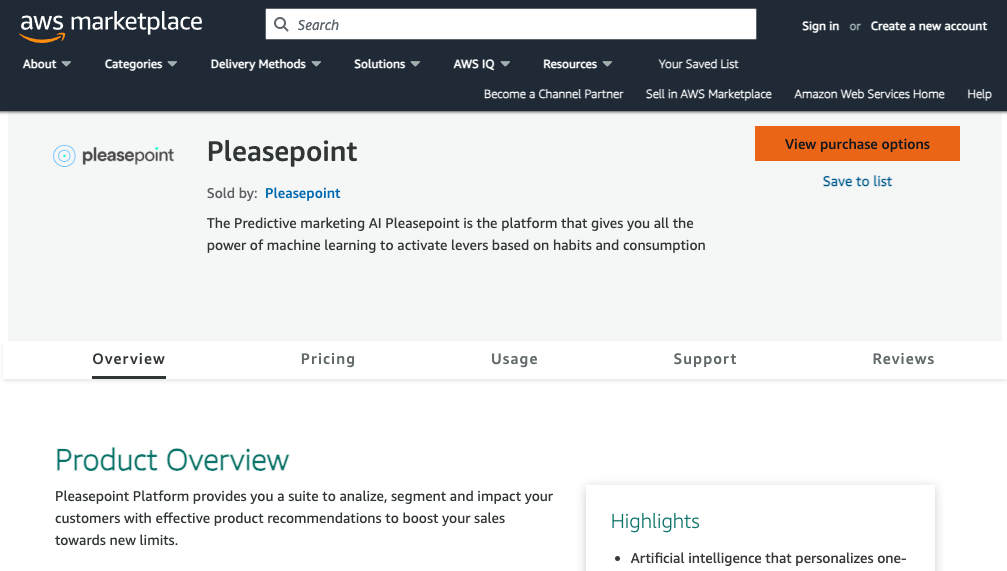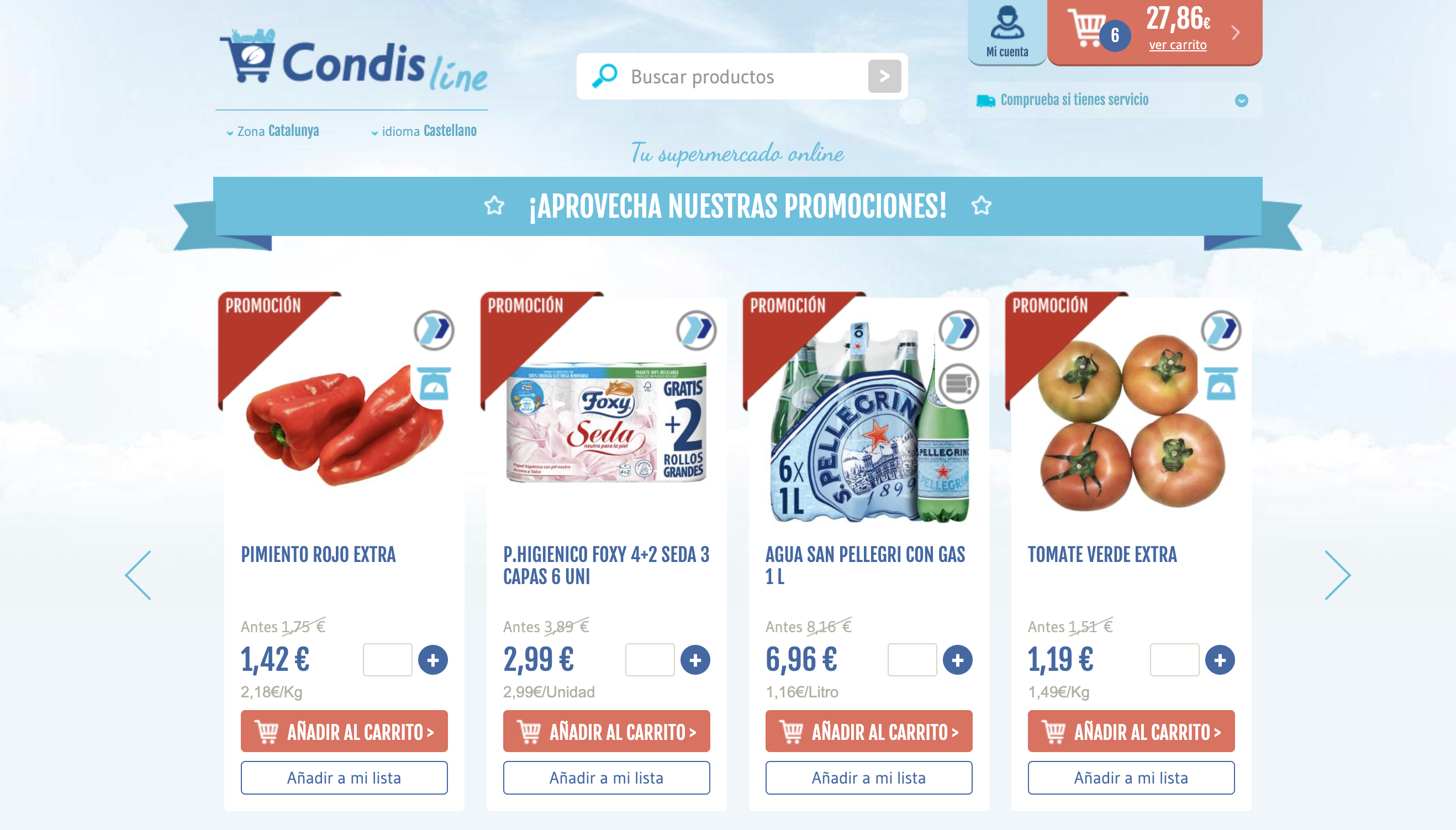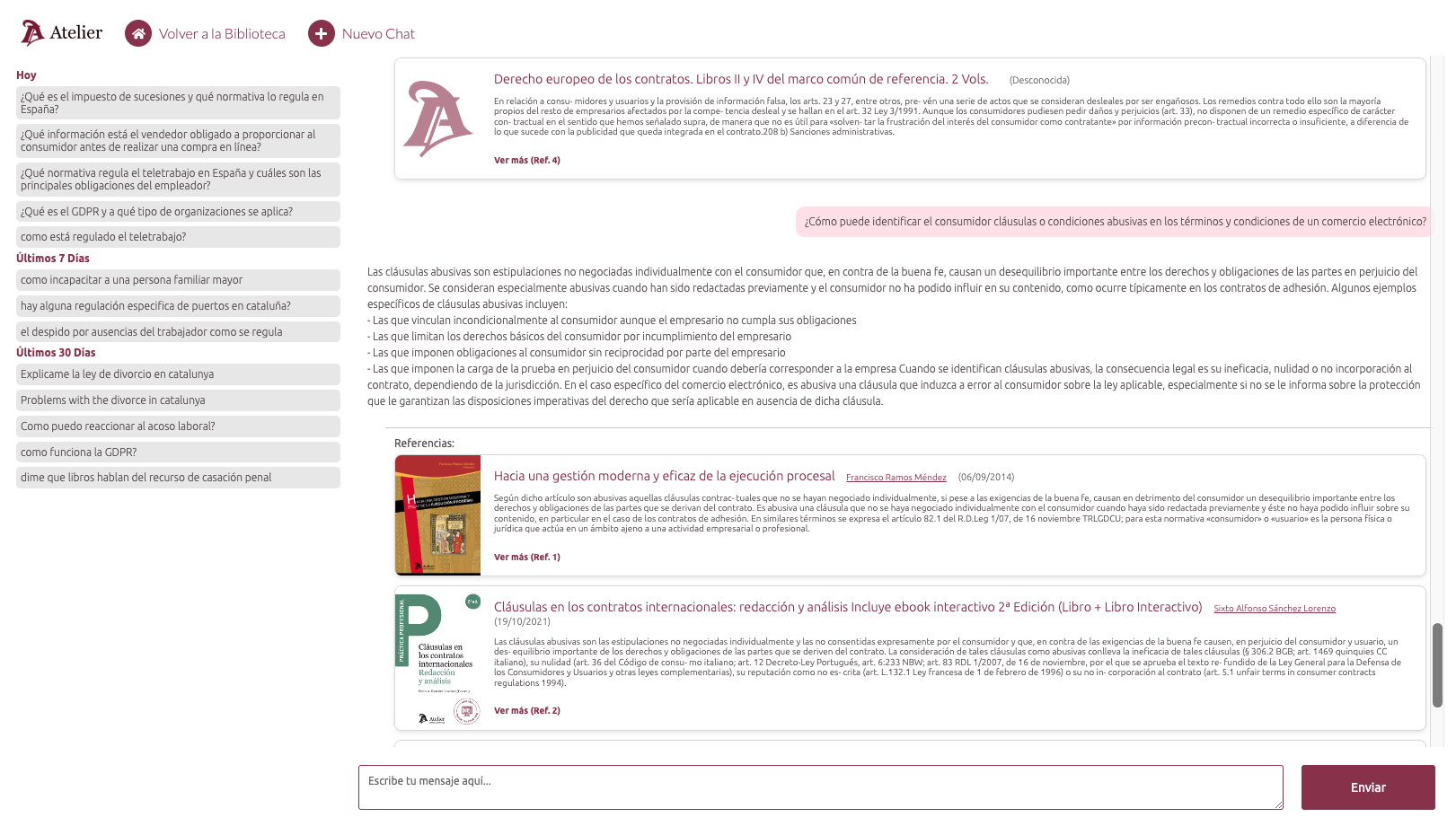Artificial intelligence has revolutionized the way companies engage with their customers. In the realm of CRM (Customer Relationship Management), one-to-one personalization has become an essential strategy to enhance customer interaction and loyalty.
If you want to see a specific success story on the results of one-to-one personalization with Pleasepoint, here is the link to the Success story: One-to-one personalization with Condis customers.
In this post, we explore five use cases of Pleasepoint's AI to show you how one-to-one personalization transforms interactions in your eCommerce. These are the topics we will cover:
- One-to-one recommendation in newsletters.
- Personalization based on purchase propensity in newsletters.
- On-top campaigns based on purchase propensity.
- Customer journeys based on lifecycle stages.
- Next best action scoring.
- Next purchase prediction.
- Conclusion on one-to-one personalization in CRM strategy.
A key tip for starting to apply one-to-one personalization use cases in your CRM strategy is to begin with an iterative, measurable approach. This means identifying a specific area in your CRM where personalization can have a significant impact, such as weekly newsletters, specific campaigns, or automations.
In the use cases you will now see, we start by implementing a pilot with a control group to compare the results of personalization against traditional strategies. Use the A/B testing methodology to measure interaction, conversion, and generated revenue.
I recommend this link to see how you can conduct A/B testing in your CRM with Pleasepoint and easily and quickly measure the results.
In each use case, we ensure that clear KPIs are established and that continuous tracking of results is performed, allowing you to validate personalization and adjust and optimize strategies based on real data.
As you observe improvements, you can gradually expand personalization with other CRM use cases, ensuring each step is supported by analysis and measurable results.
1. One-to-one recommendation in newsletters.
One-to-one product recommendations in newsletters are based on the purchase history and interactions of each registered user. Aligning these recommendations with the commercial strategy of the campaign results in highly relevant content for each customer.

Objective: Increase engagement with the newsletter through more relevant content and visits more likely to result in purchases. Each newsletter offers products tailored to each user according to the campaign content.
Pilot: A test is conducted with a control group to validate the results of one-to-one recommendations in newsletters. The performance of the audience receiving personalized products is compared with those receiving a general selection.
Results and benefits:
- 12% increase in product interaction within the newsletter.
- 233% increase in conversion and 173% increase in revenue from the newsletter.
- Automation of product selection in newsletters.
Learn how to personalize one-to-one product offerings in each of your CRM newsletters.
2. Personalization based on purchase propensity in newsletters.
Content personalization in newsletters for each registered user is based on purchase propensity. This includes personalizing banners, promotions, and featured categories or brands according to the user’s preferences.
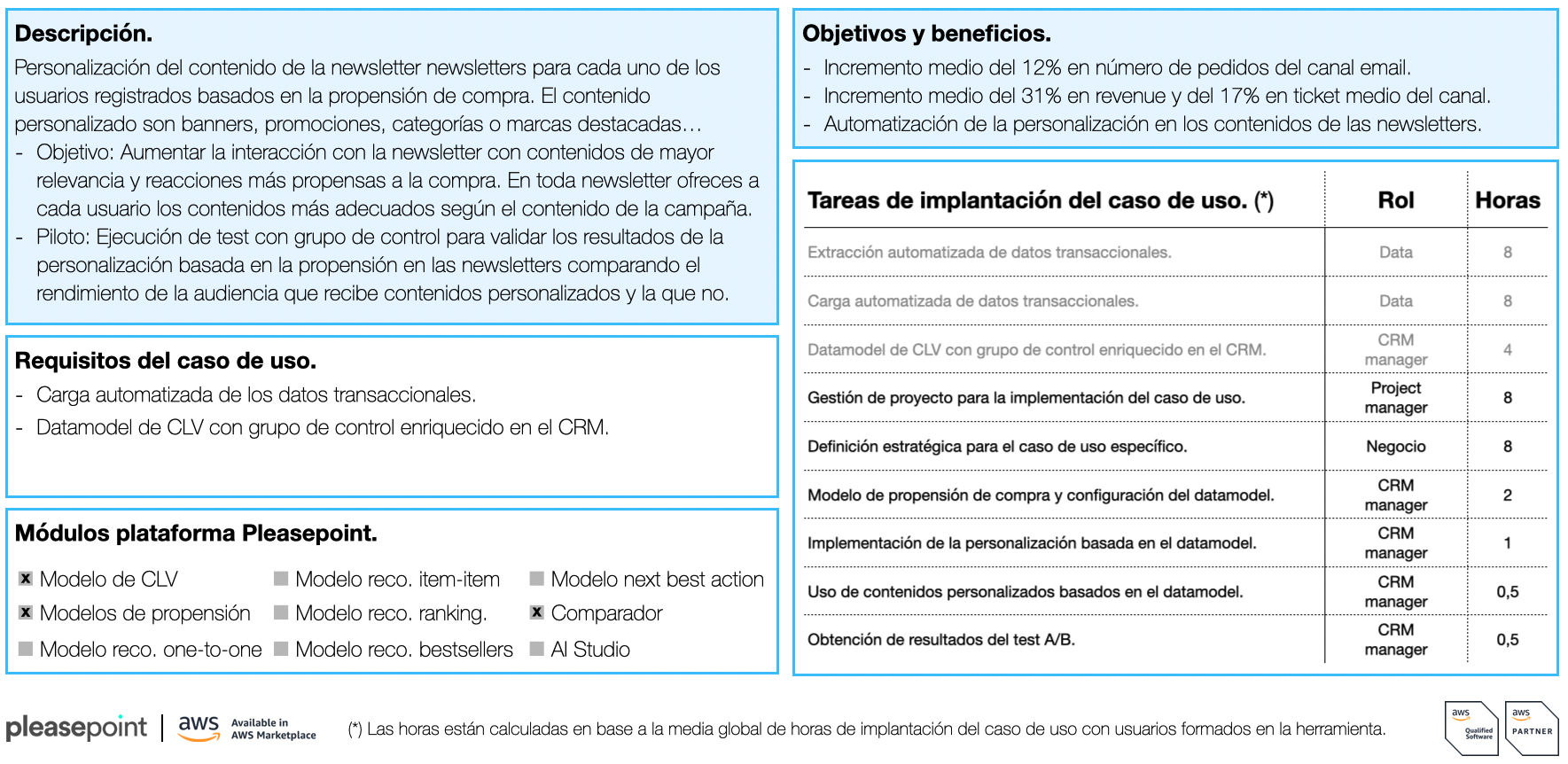
Objective: Increase engagement with the newsletter through more relevant content and interactions more likely to lead to purchases. Each user receives content most suited to them according to the campaign.
Pilot: A test is conducted with a control group to validate the results of propensity-based personalization in newsletters. The performance of the audience receiving personalized content is compared with those who do not.
Results and benefits:
- Average 12% increase in orders from the email channel.
- Average 31% increase in revenue and 17% increase in average ticket size from the channel.
- Automation of content personalization in newsletters.
Learn how to enrich your CRM’s customer data with purchase propensity information.
3. On-top campaigns based on purchase propensity.
Additional personalized campaigns are created based on the purchase propensity of each registered user. These campaigns feature an audience with similar preferences and receive content adapted to their interests.
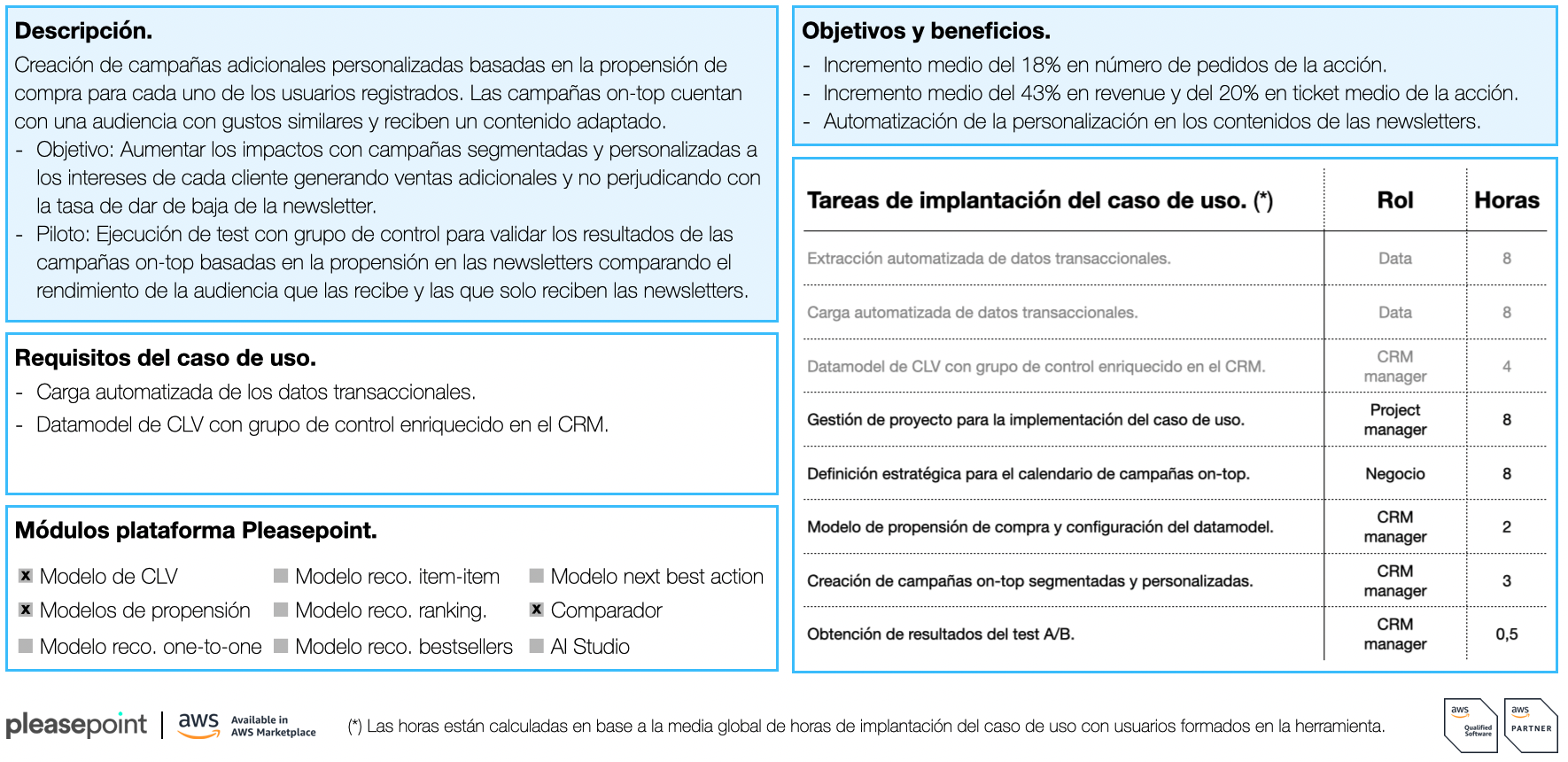
Objective: Increase impressions with segmented and personalized campaigns tailored to each customer’s interests, generating additional sales without affecting the newsletter unsubscribe rate.
Pilot: A test is conducted with a control group to validate the results of on-top campaigns based on purchase propensity in newsletters. The performance of the audience receiving these campaigns is compared with those receiving only regular newsletters.
Results and benefits:
- Average 18% increase in orders from the campaign.
- Average 43% increase in revenue and 20% increase in average ticket size from the campaign.
- Automation of content personalization in newsletters.
4. Customer journeys based on lifecycle stages.
Customer journeys based on each client’s lifecycle use communications adapted to their purchase cycle, loyalty status, and individual progression.
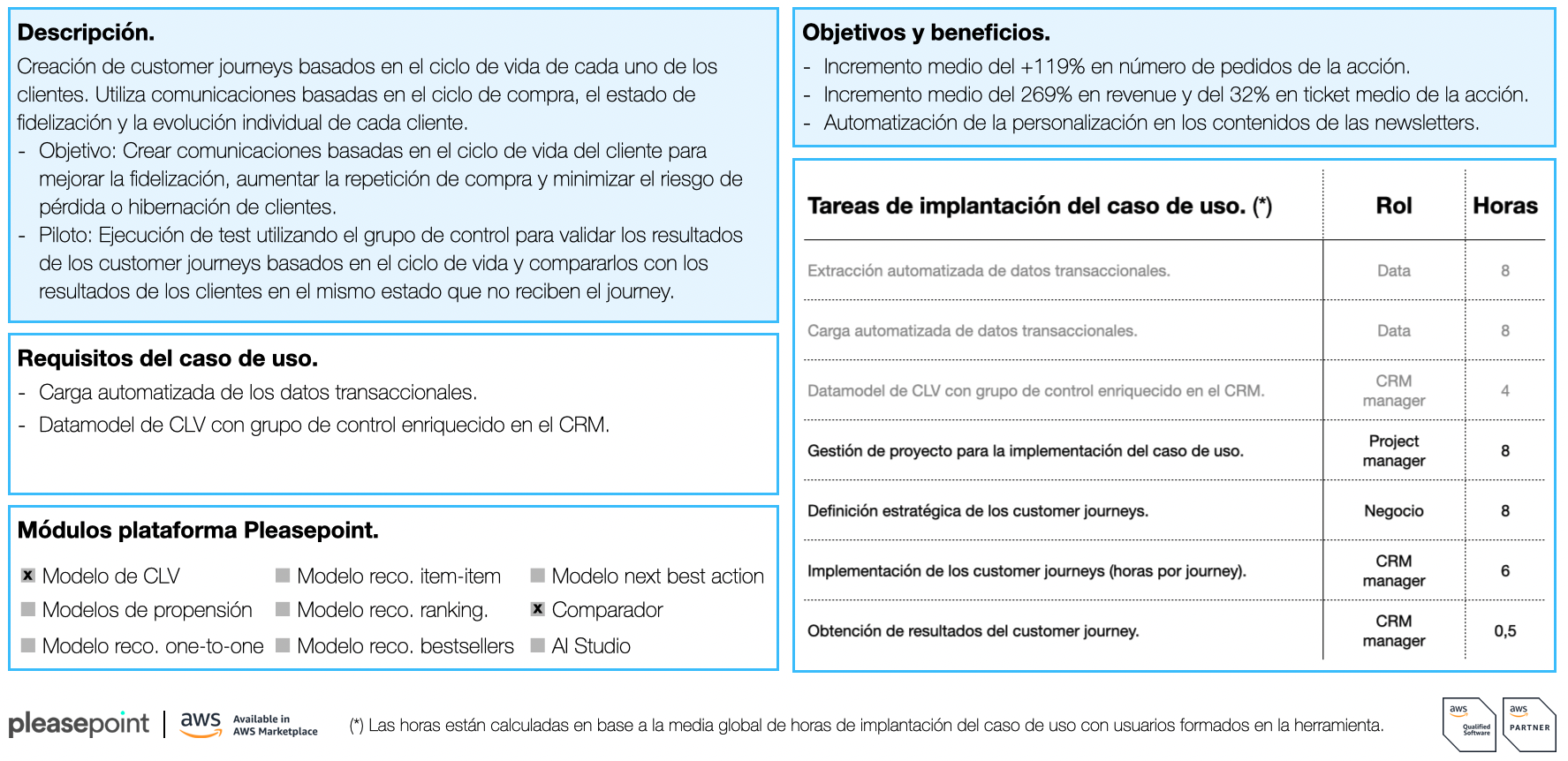
Objective: Create communications based on the customer’s lifecycle to improve loyalty, increase repeat purchases, and minimize the risk of churn or dormancy.
Pilot: A test is conducted with a control group to validate the results of lifecycle-based customer journeys. Results are compared with customers in the same stage who do not receive the journey.
Results and benefits:
- Average 119% increase in orders from the campaign.
- Average 269% increase in revenue and 32% increase in average ticket size from the campaign.
- Automation of content personalization in newsletters.
Learn how to enrich your CRM’s customer data with lifecycle stage information.
5. Next best action scoring.
The one-to-one recommendation of the next best available commercial action is generated for each customer, automatically creating audiences for each action and improving campaign performance.
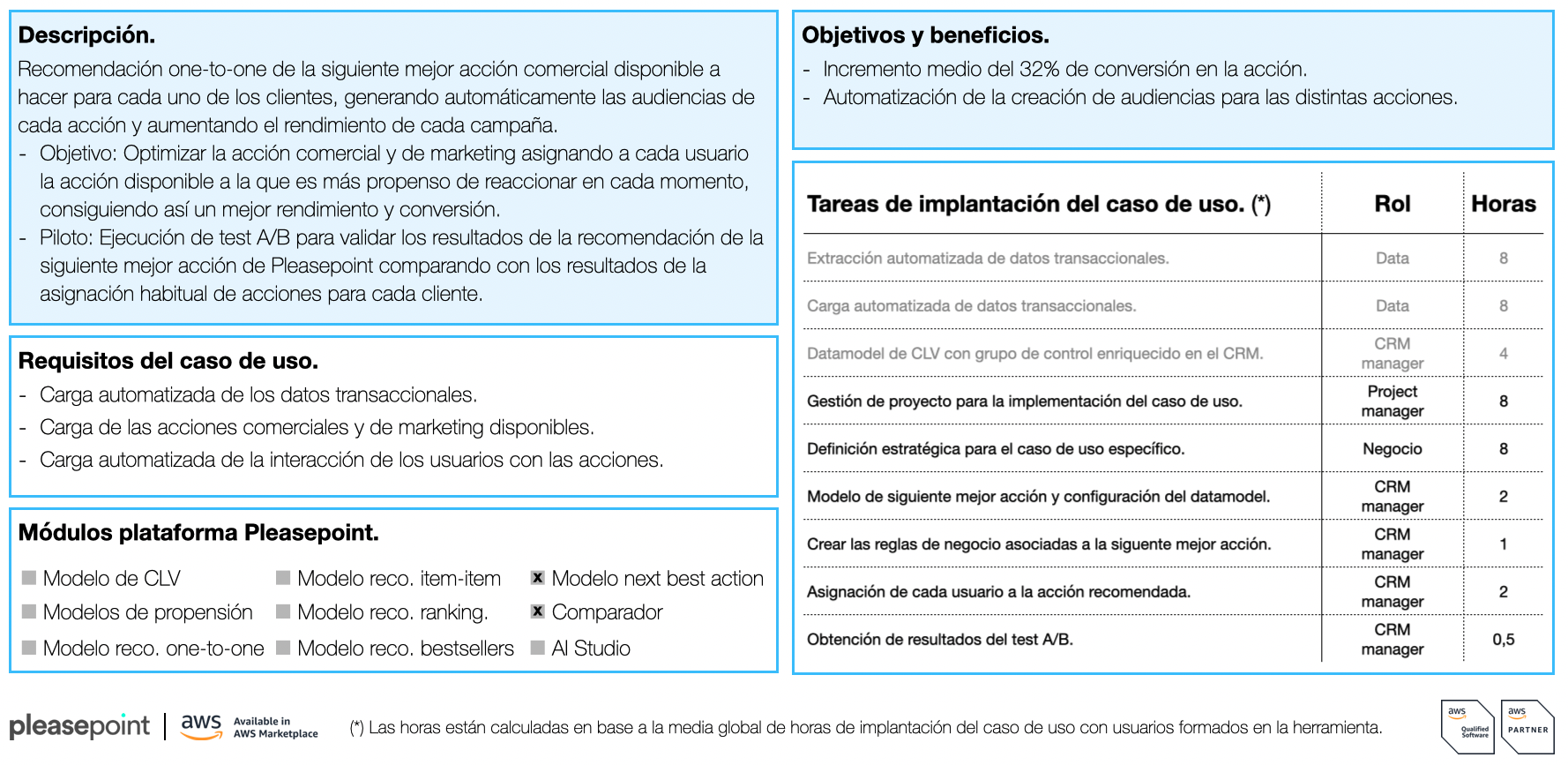
Objective: Optimize commercial and marketing actions by assigning each user the most relevant action they are likely to react to, achieving better performance and conversion.
Pilot: An A/B test is conducted to validate the results of Pleasepoint’s next best action recommendation, comparing it with the usual action assignment for each customer.
Results and benefits:
- Average 32% increase in action conversion.
- Automation of audience creation for various actions.
- Automation of campaign or commercial action selection for each user.
6. Next purchase prediction.
The prediction of the next purchase time for each user utilizes neural networks based on time series, allowing specific communication to those customers with a higher propensity to purchase.
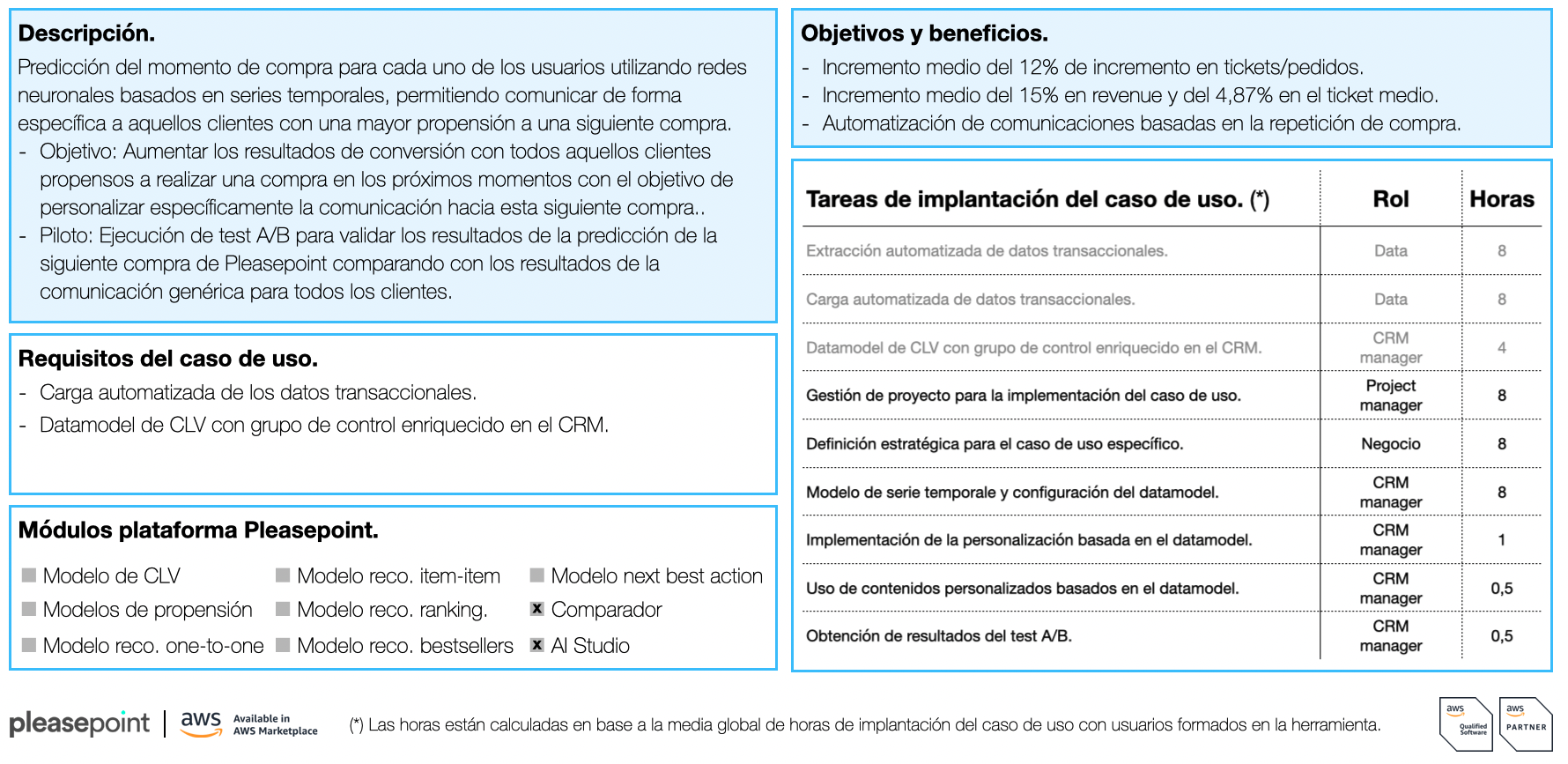
Objective: Increase conversion results with customers likely to make a purchase soon by specifically targeting communication towards their next purchase.
Pilot: An A/B test is conducted to validate the results of Pleasepoint’s next purchase prediction, comparing it with the results of generic communication to all customers.
Results and benefits:
- Average 12% increase in tickets/orders.
- Average 15% increase in revenue and 4.87% increase in average ticket size.
- Automation of communications based on repeat purchases.
Conclusion on one-to-one personalization in CRM strategy.
Implementing specific one-to-one personalization use cases in CRM strategy has proven crucial for sustainable growth and improving customer relationships. The results are clear: providing highly relevant product recommendations significantly boosts upselling. When customers receive suggestions that perfectly align with their interests and shopping behavior, conversion rates increase, generating more sales and maximizing the value of each interaction.
Beyond sales, one-to-one personalization strengthens user loyalty. When customers feel understood and valued, they develop a deeper connection with the brand, translating into greater loyalty and a lower propensity to switch to competitors. This strategy creates an experience that goes beyond the transaction, building a relationship of trust and continuous satisfaction.
Personalization also positively impacts repeat purchases. Tools like next purchase prediction and next best action recommendations anticipate customer needs and offer incentives at the optimal time. This increases purchase frequency and improves customer lifetime value, a key indicator of long-term success.
In conclusion, one-to-one personalization in CRM strategy is essential for any company looking not only to increase sales but also to strengthen customer relationships and improve repeat purchases. Adopting this technology transforms the customer relationship, creating a stronger and longer-lasting bond. Investing in personalization and Pleasepoint’s artificial intelligence is not just a competitive advantage, but a necessity in today’s business environment. Companies that do so will be better positioned to lead in their markets and meet the ever-growing expectations of modern consumers.
